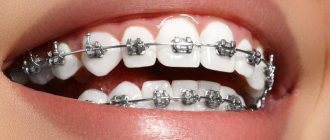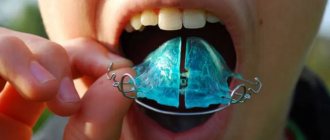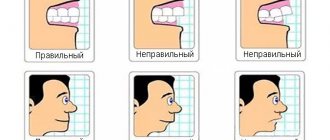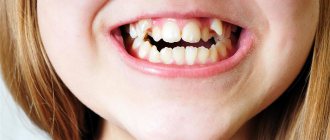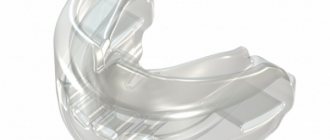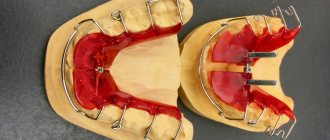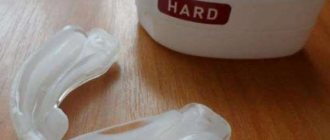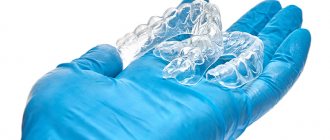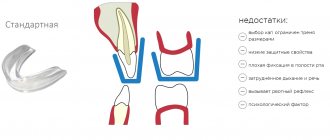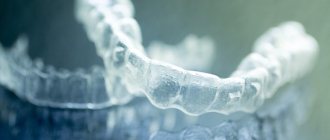Beautiful, straight teeth and a snow-white smile are a gift that nature does not bestow on everyone. Fortunately, today there are several effective techniques that can straighten teeth in childhood and provide a person with a luxurious smile for life. And the most popular way to improve their appearance is to install plates.
Today we will talk about what dental plates are, how long it will take to straighten a child’s teeth and how to choose the right smile helpers.
What are dental plates?
An orthodontic plate for teeth is a removable structure made of soft plastic and wire. This device is made individually from hypoallergenic materials and is not traumatic to the oral mucosa. Plates for straightening teeth can be either single- or double-jawed, depending on the diagnosis. They can be supplemented with a “hand-shaped process”, which is used to move only one tooth. The device may also contain a retraction arch designed to correct the position of the front teeth. Separate types of plates for teeth are Brückle and Frenkel devices. Look at the photo below to see what the plate looks like on your teeth.
How to use the device
The device for straightening the teeth is worn from six months to three years. This depends on the severity of the pathology of the dental system. It is prescribed to be worn up to twenty-two per day. It is allowed to remove before eating, caring for the oral cavity and the plate. It is cleaned with a toothbrush and then washed with water. A paste without abrasives is used. The device is easily installed on the child’s jaw and does not require special skills. It needs to be tightened regularly, as the orthodontist explains and demonstrates to parents how to do this. They are given individually in each individual case. Store the plate when not in use in a special case.
Types of dental plates
Depending on the diagnosis, the doctor determines the types of dental plates. In some cases, only a plate is installed for the teeth of the lower jaw. This design refers to mechanically operating devices, that is, its action depends on the elasticity of the component parts. They use the force of an orthodontic screw, wire, ligature, or rubber ring. To increase space in the dentition at the stage of mixed dentition, an expanding plate for the teeth of the upper jaw, based on a Bertoni screw, is also used. The screw is installed on the working model of the jaw in the deep part of the dome of the palate so that it is parallel to the occlusal plane. This design needs to be tightened from time to time; we will tell you how to do this a little later.
Plastic surgery for lower jaw teeth
Upper jaw plate
Indications for installation of orthodontic plates
The main indications for the installation of orthodontic plates for children are:
· adjusting the distance between teeth and eliminating gaps (diastemas and threes) between them;
· change in the width of the sky;
· acceleration or deceleration of jaw growth, as well as correction of its shape (for example, eliminating narrowness);
· displacement of incorrectly located teeth and their fixation in the right place;
· preventing further curvature (crowding) of the dentition;
· correction of the bite and prevention of relapses of its violation.
When should a plate be placed on a child’s teeth?
The dental plate is not suitable for adult patients. This is an exclusively children's orthodontic device. First of all, plates for straightening teeth in children are used up to 12 years of age. During this period, there is active growth of the jaws, which makes it possible to quite effectively correct the bite, eliminate crowding and remove other occlusion anomalies. When the jaw bones have formed, it is only possible to align the teeth within the dentition. And correction of bite in adult patients is only possible with the help of braces and orthognathic surgery. In this regard, parents should not delay visiting a specialist, even if it is a preventative one, if treatment is not required. Orthodontists recommend placing a plate on a child’s teeth to achieve the following treatment goals:
- correction of jaw shape;
- regulation of jaw growth;
- correct placement of incisors in a row;
- increasing or decreasing the size of the sky.
Consumer Reviews
Levi (otzovik.com)
“The issue of children's toothpaste seems trivial until the day comes when it is needed. On the one hand, it’s clear that in our childhood our parents didn’t have such problems, I remember very well how in preschool age the dentist recommended brushing your teeth with a brush and soap) But since now is the age of information and the Internet, you go into at least a little depth into any question concerning your beloved children .
Therefore, first is a list of my requirements for children's toothpaste:
1) lack of SLS;
2) lack of fluoride, so the child often swallows the paste;
3) a small degree of abrasiveness, as well as the absence of calcium carbonate (chalk) and sodium bicarbonate (soda) responsible for it.
Asepta Kids toothpaste initially came to our house in a promotional tube. My son is conservative in his habits - he looked sideways at the new mini-tube with disbelief for a long time, then he tried it and ordered to buy him just such a paste.
After studying the composition and description of the toothpaste, I came to the conclusion that manufacturers of children's toothpastes know better than parents. In large letters and in plain text they write what their paste does not contain:
The degree of imageability is not indicated by a number (it should be within 50), but by general words, forming - silicon dioxide.
Contains no: fluorine, SLS, parabens. This is confirmed by the fact that the paste hardly foams.
The color of Asepta Kids paste is calm, slightly yellowish:
The taste is described as tutti fruiti - indeed, it resembles a sweetish candy, the rough particles are well felt.
The smell is the same as the taste, sweetish.
It is squeezed out neatly and easily, the child can easily go through the whole process on his own.
After brushing, my teeth are white and beautiful, I hope Asepta Kids will help keep them that way.”
Eoleksa (otzovik.com)
“Good afternoon to all visitors and guests of the Otzovik website!
We bought new toothpaste for our grandchildren. This time we decided to make a purchase at a pharmacy, and not at a regular shopping center. The choice fell on Aserta toothpaste; the toothpaste is not cheap.
This brand was presented with pastes for both children and adults. Rpsta in the form of a gel, soft, pleasant aroma. The kids like it. main properties: preventing caries and helping to strengthen tooth enamel. Children's volume - 50 ml. The design is so-so for me - nothing special. On the package itself there is a paper label with the price and expiration date.
The tube itself looks identical, after squeezing out the paste it becomes shapeless, especially since only children use it. The tube indicates the age for which this toothpaste is intended - we fit exactly into this category - 5.7 years.
The paste is of an unusual color, perhaps depending on the composition of the product (the paste contains extracts of aloe, chamomile, witch hazel), which is why the color is so “medicinal”. Since children like the aroma of the toothpaste, they brush their teeth with pleasure, but they need to be constantly reminded not to forget about this hygiene procedure.
I recommend this paste for purchase for several reasons:
- contains calcium (it strengthens tooth enamel, prevents the penetration of microbes)
- there are components that prevent caries,
- pleasant aroma, economical use,
- protects the child's gums from inflammatory processes. I think this is quite enough."
How to place a plate on a child’s teeth?
Installing plates on children's teeth usually takes several weeks, since they are made individually for each patient. To create a suitable orthodontic appliance, the patient undergoes an X-ray examination, then the doctor takes an impression of the teeth for the plate. After this, plaster models are made, from which the structures are created. Particular attention is paid to the exact match of the surface relief of the gums and the palate - the adjustment takes just over 10 minutes. After this, the child will be able to independently remove and put on the plate on the lower teeth and upper jaw.
How to fix a deep bite?
So, how can you correct a deep bite when it’s too late to think about prevention? The choice of treatment for deep occlusion depends on the type of anomaly and the age of the patient. So, for very young children, as we have already said, it is necessary, first of all, to normalize breathing, as well as restore missing and damaged teeth - and then after some time they will begin to close correctly.
At a more mature age, at approximately 5 - 11 years, deep bite treatment is carried out using a plate with a bite pad. It increases the load on the lower front teeth, as a result of which they become smaller, and the lateral ones, on the contrary, become longer, which leads to normalization of occlusion.
How long do you wear plates on your teeth and how to wear them?
The main problem with this type of treatment is that children need to wear removable dental plates 22–23 hours a day. The course of treatment can last from a year to a year and a half, with replacement of the structure required every 6 to 8 months. Like any orthodontic device, plates for baby teeth require some getting used to. Children often complain that their teeth hurt from the plate; this is normal. Usually the discomfort disappears 5 to 6 days after installation.
Wearing dental plates often confuses children, but it is worth explaining to the child that they are less noticeable and more comfortable than metal braces, which will have to be worn in adolescence without timely treatment. Children's dental plates are often made of plastic in bright colors so that the child enjoys wearing them.
Advantages and disadvantages
The main advantage of the record is its low price. Anyone can afford to use this method by contacting any nearest dental clinic. This design is made from budget materials, due to which its price always remains reasonable. In addition, the installation procedure itself does not require much time and effort. This allows you to save significantly on it.
A big plus is that the plate does not have any negative effect on tooth enamel. The materials used for its manufacture do not react with the tooth surface, which means they leave it completely healthy. In addition, the brushing process itself with a plate allows you to completely brush the entire surface of the tooth, which cannot be done when using braces. Thus, after the end of the treatment period, additional teeth cleaning or whitening is not required.
As for the disadvantages, in this case we can highlight the following:
- The plate is not able to solve significant defects in the dentition. It is used only for the correction of minor curvatures.
- Wearing the plate in the early stages may cause discomfort for the patient due to its large size. However, over time, a person gets used to it and stops noticing the structure in his mouth.
- In the first days of using the plates, minor speech defects may be observed, which completely disappear over time.
Often, after several weeks of wearing the structure, the patient completely gets used to it, and it does not bring him any discomfort. In addition, he can always turn to a specialist to eliminate certain design flaws in order to make it as convenient as possible for use.
How to tighten a dental plate?
The twisting procedure is necessary to increase the load, as well as expand the main surface of the plate, which is installed on the upper jaw. Your doctor will tell you how to tighten the dental plate and how often to do it. The process itself is not too complicated: using a key inserted into the main hole of the screw, one turn is made along the guide arrow on the tooth plate. After this, the child may feel discomfort for some time, but this procedure is necessary to achieve the desired result. In addition, if necessary, the plate can be returned to its previous position by turning back.
Dental plastic with a key for twisting
Photos before and after wearing a dental plate - what the result of treatment looks like
Treatment of malocclusion or dentition is not a quick process, but the result speaks for itself. For example, here are the “after” photos.
How to care for a dental plate?
When wearing a removable structure, the child needs to handle it carefully and avoid damage or loss, as well as properly care for it. You need to remove the plate from your teeth before each meal and be sure to clean it every day with a special brush and gel. It is better to store records in a container. Particular attention must be paid to the little patient’s own oral hygiene. That is why dentists usually give a short lecture to the child, in which they explain all the rules for handling this structure.
Container for dental plates
Why do children need to correct their bite?
Signs of malocclusion or uneven teeth make parents think about what measures to take to improve the situation. However, there is an opinion that there is no need to rush, since most problems with bite will level out on their own as the baby grows. They think about it only if the violations are gross and disfigure their appearance. Even a minor defect in a child only gets worse as he grows, leading to health problems.
Malocclusions lead to the development of the following diseases:
- premature destruction of teeth;
- diseases of the digestive tract due to disruption of the process of chewing food;
- dysfunction of the jaw joint;
- development of skeletal defects in the facial part;
- pathologies of ENT organs;
- disturbances in posture and gait;
- pathological abrasion of teeth;
- formation of psychological complexes;
- headache.
The sooner parents think about correcting defects in bite and dentition, the easier and cheaper it is to correct even serious anomalies.
Plates or braces for teeth?
This choice cannot stand - dental plates and braces have different functions. The former affect the entire dentition, the latter have a wide range of functions and solve various orthodontic problems: from the curvature of individual teeth to malocclusion and crowding. Also, the plate cannot be placed if the child has developed traumatic periodontitis, in which a fracture of the cortical plate of the tooth is possible. However, these two devices can be used in combination - first the child will be given a plate, and then braces.
Manufacturing and installation
Each of the plates is made exclusively to individual order, based on the specific structure of the dentition of each individual patient. To do this, the specialist makes an impression, which will become the basis for the manufacture of the structure. The patient may first be prescribed a dental x-ray, which will reveal any hidden damage that could also affect the general condition of the jaw.
When the cast is ready, it takes a little time to make a preliminary layout. Next, the patient is given an appointment to try it on. If the design is suitable and the person feels comfortable with it, a real plate is made for him.
The structure is put on the dentition directly at the doctor’s appointment so that the specialist can set the optimal pressure level using a screw. Next, you need to visit a doctor at least once a month to correct the pressure on the dentition.
The cost of a dental plate in Moscow
The average cost of dental plates for children in Moscow varies from 8 to 15 thousand rubles. Do not forget that the design requires periodic correction and replacement, so visits to the doctor must be included in the total cost. You should also take into account other factors that affect the price, for example, the level of pediatric dentistry and the qualifications of specialists. In any case, you shouldn’t go after cheapness; the cost of dental plates for children should not be too low - the child’s health is more expensive.
Benefits of this treatment method
The plates enjoy consistently high popularity and are unlikely to go out of use in the foreseeable future because:
- They are light, comfortable, non-traumatic.
- They are very easy to care for from a hygienic point of view.
- They look quite aesthetically pleasing and do not cause negative emotions even in the most suspicious patients.
- Their installation and correction requires a minimum of time and effort.
- They cause virtually no pain or inconvenience to patients.
- Their cost is always kept at a reasonable level and is accessible to the widest segments of the population.
At what age can you wear it?
The most optimal age when an orthodontist can prescribe wearing plates is about 5–6 years. This age can be extended to 10–12 years. 5 years is the recommended, but not always the limit norm. Despite the fact that children's dentition has not yet been formed, anomalies in its development may appear earlier.
If there is a special need, the dentist can recommend one of the gentle plate options before the age of five – at 3–4 years. Here everything depends on the expected result - how great the benefit from the orthodontic apparatus will be.
Types of plates
Based on the principle of purpose and structure, there are several subtypes of removable plates:
- Single jaw plates. They are used to restore the dentition in case of excessive shortening and (or) narrowing. Also used to correct deformities of individual teeth. They are a structure consisting of a plate base and screws that are tightened at the right time. Suitable for patients of all age groups.
- With retraction arch. Suitable for both jaws. They help correct the protrussin position of the dentition. The effect is achieved due to the spring properties of the arc.
- With a hand-shaped process. Attached to the upper or lower jaw. Corrects the position of individual teeth. The process, which is a distinctive part of the structure, acts on the deformed tooth, gradually moving it to the correct position.
- With active pusher. It is used to restore the frontal dentition. The effect is achieved by spring mechanisms included in the design.
- Andrez-Goipl activator. This plate consists of two parts connected to each other, put on parallel to both jaws. They target several dental defects at once.
- Bruckle's apparatus. Its action is aimed at correcting bite problems in the anterior dentition of the lower jaw.
- Frenkel apparatus. It is a structure of cheek shields, lip pads and other additional parts. They are connected by a frame into a one-piece structure that corrects mesial, distal and open bites.
What results can be achieved?
Sometimes the use of plates in childhood precedes the subsequent installation of braces. However, in most cases, with the help of such orthodontic appliances, it is possible to avoid treatment with fixed structures or make it shorter.
The sooner you start correcting your bite, while the dentition is easily corrected, the greater the likelihood of a complete recovery.
In adults, the result, at first glance, is less noticeable. Especially when the plates are used as retainers, holding teeth in the correct position after removing the braces. However, these structures prevent repeated changes in the bite and allow a person to live a full life .
Is it painful to wear?
Patients do not experience severe pain even during the adaptation period - for several days while they get used to the orthodontic apparatus. However, many may experience quite severe discomfort. In this case, discomfort is almost always associated with the presence of a foreign solid object in the mouth.
Basically, all unpleasant sensations go away in a maximum of a week and a half. However, in cases where wearing is not indicated constantly, but only for a certain number of hours during the day, addiction can extend over a longer period.
How to relieve pain - recommendations from dentists
Experts from the “Smile” dental network, based on their practical experience, advise:
- Before going to the procedure for installing braces, you need to get a good night's sleep, have a hearty snack in advance, and not worry. If you still have anxiety, you can take a light sedative;
- when wearing a brace system at the initial stage, in order to minimize friction of the lips and tongue on the structural elements, it is recommended to use specialized wax for braces;
- to eliminate pain while eating, foods should be cut finely and not eat hard foods;
- If pain interferes with your normal routine, you can take painkillers. But their use should not be constant.
Important:
sensations at all stages of treatment are purely individual. Therefore, only an orthodontist can give correct advice based on a specific clinical situation.
